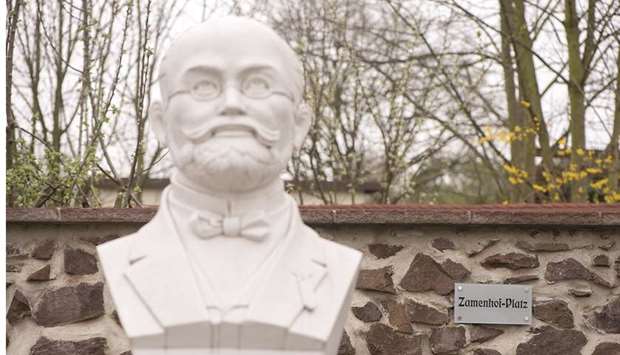noblest of beginnings. And despite the difficulties of promoting a constructed language,
it still has a large cohort of fans all around the world. By Christian Brahmann
In the central German town of Herzberg, people speak Esperanto: “Herzberg estas pitoreska urbo,” meaning “Herzberg is a picturesque town,” for example.
Peter Zilvar, director of the Interkultura Centro Herzberg (Esperanto for “Intercultural Centre of Herzberg”), has been leading a campaign to literally spread the word for the past 40 years, and a square in the town was recently named after the inventor of the international language, Ludwik Zamenhof.
“The language is significantly easier than any other language. You can learn it in around a third of the time,” says Zilvar.
Zilvar has around 120 comrades-in-arms in the region and their campaign has led to the introduction of bilingual signs at the city’s station and in some restaurants.
There was already a marble bust of Zamenhof at the previously nameless square so it wasn’t a big leap for Herzberg, which calls itself “Esperanto city,” to name it after him.
“The Esperanto society has worked really hard for the language and we support that,” says the local mayor, Lutz Peters.
Herzberg is not the only place in the world where Esperanto still has a surprisingly strong hold. It’s not known how many Esperanto speakers there are, though estimates put it at around 2 million worldwide.
Very few people know that around 200 books are published in Esperanto every year. There are even Esperanto-only publishers, distributors and literature magazines in which reviews of the books appear.
The foreign-language app Duolingo has around 800,000 registered Esperanto learners.
Zamenhof was born in the second half of the 19th century in the town of Bialystok in what is now northern Poland, and which was then part of the former Russian Empire.
Its inhabitants were a mix of Jews, Poles, Russians and Germans, and Zamenhof came to believe that the frequent conflicts between the groups were the result of language barriers.
It gave him the idea for an international language that would be easy to learn, and he put together his first draft in 1878 at the age of just 19.
“In the first Esperanto book in 1887, Zamenhof came up with three main aims for his language,” says Louis von Wunsch-Rolshoven of the German Esperanto Association in Berlin.
First, it should be easy to learn; second, it should be internationally useful; and third, it should be available to the masses.
As a consequence, Esperanto has just one article, three tenses and 16 grammatical rules, with no exceptions.
“The third goal, to make the language an international mode of communication in addition to people’s native tongues, has not happened,” says linguist Sabine Fiedler at the University of Leipzig.
Languages don’t become important because they sound nice or they’re easy to learn, but because of the power and attractiveness of the countries to which they belong, she adds.
“Esperanto doesn’t have a lobby group and there are no signs that that will change,” she says. “The community of Esperanto speakers is relatively small.”
But it’s big enough that the language still has a future. “Esperanto is no failed project. It’s just not well known enough that we can guess at its potential,” says Fiedler.
“There are Esperanto meetings at local, national and international levels at
which only Esperanto is spoken and
there’s an annual world congress,” says Fiedler.
“Even if Esperanto doesn’t become a world language in the immediate future, we are carrying on with Zamenhof’s ideas,” says Zilvar in Herzberg.
Zamenhof would doubtless be pleased – Esperanto means “A hopeful one.” -DPA

